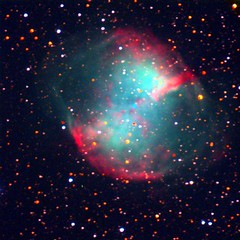
M27 - The Dumbell Nebula
Originally uploaded by Astro Guy.
The photo above is of M27, the dumbbell Nebula. The blue dot in the centre used to like our Sun, but it's now running out of fuel in its core to burn. As this happens outer layers of the star are becoming gravitationally unstable and leave the star driven away by photon pressure and treats us to beautiful sites. The bluish-green gas is due to forbidden transition lines of Oxygen (absorption and emission of photos) and the red gas is due to Hydrogen. One day our Sun will probably do this as well, but don't work thats billions of years away.
The image itself was obtained at the Dominion Astrophysical Observatory (DAO) in Victoria British Columbia. I acquired 3 60 second exposures in B,V and R and then assembled the image you see in front of you.
Now on to my current work:
Today started off lousy, but ended up with a good ending (well, the day isn't over yet).
When I extract photometry from the raw CCD MOST satellite images I usually do not have any dark/flat calibration frames. The dark frame measures both the bias offset and identifies hot pixels on the frame. The flat image is used to measure the differential gain from pixel to pixel. Both of these are important if your target of interest changes position in each image. The MOST satellite seems to have a crack in the side of it. It was probably created during the launch process. This has been a nuisance as it allows stray light (mostly from the Earth itself) to reach the CCD detectors and peaks once per orbit (about 14 times per day). This causes all sorts of problems that I theories to explain, but I'll leave that for another day. The point today, is that I can abuse the stray light to generate local dark/flat fields for each subraster on the CCD. If I assume that the straylight is a uniform source over a 20x20 subraster (good approximation) then I can compare the individual pixel counts compared to the mean. If any pixel increases in brightness faster than the others, this is interepted as a gain difference. Likewise I can measure a zero point (the value of the pixel with no light) which is the dark/bias value.
In practice this works well, especially for dim stars. The problem I've encountered is that the amplitudes of variable stars gets distorted. Initially I thought this was because I was using PSF fitting photometry opposed to pure aperture photometry, but that is not the case. In fact, it's the gain variations that are causing this effect. I never made sure to check that the overall gain corrections come out to 1. In fact they usually come out to about 1.2 or something like that. In other words, I forgot to normalize my flatfield to 1. So simple, Oh well, at least I caught it and have time to make corrections to the datasets for which it is critical! Luckily, absolute amplitudes are usually useless as MOST uses a unique filter (300-700 nm broadband filter!). If anything, it's the relative amplitudes that are important and this is perserved. Plus I have all the raw photometry to compare to as well, so this looks like a bookkeeping exercise.
No comments:
Post a Comment